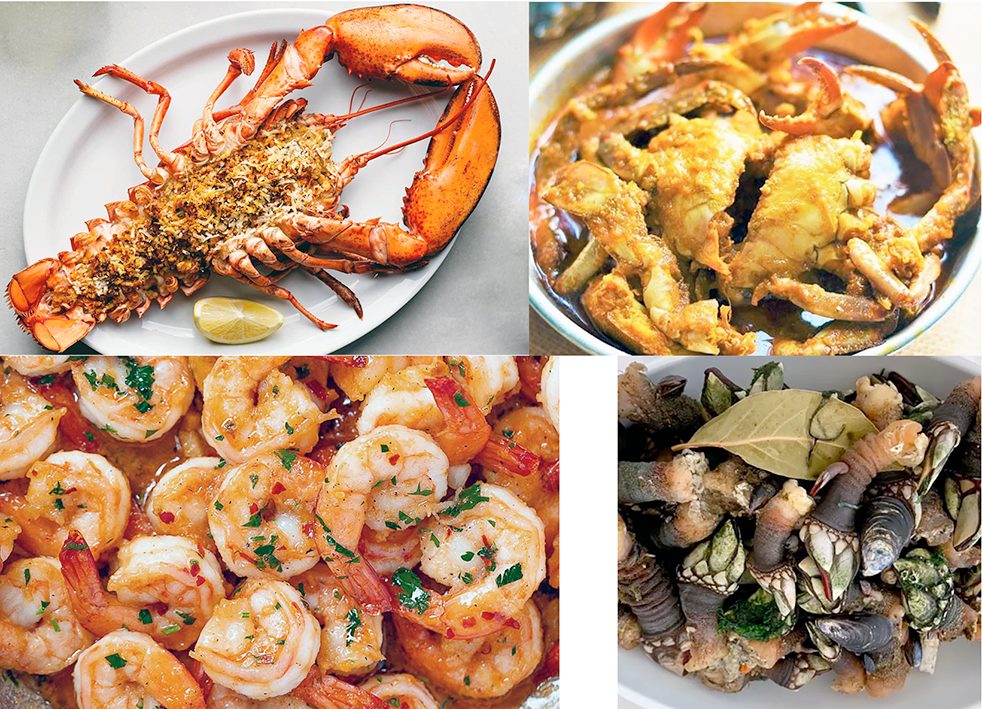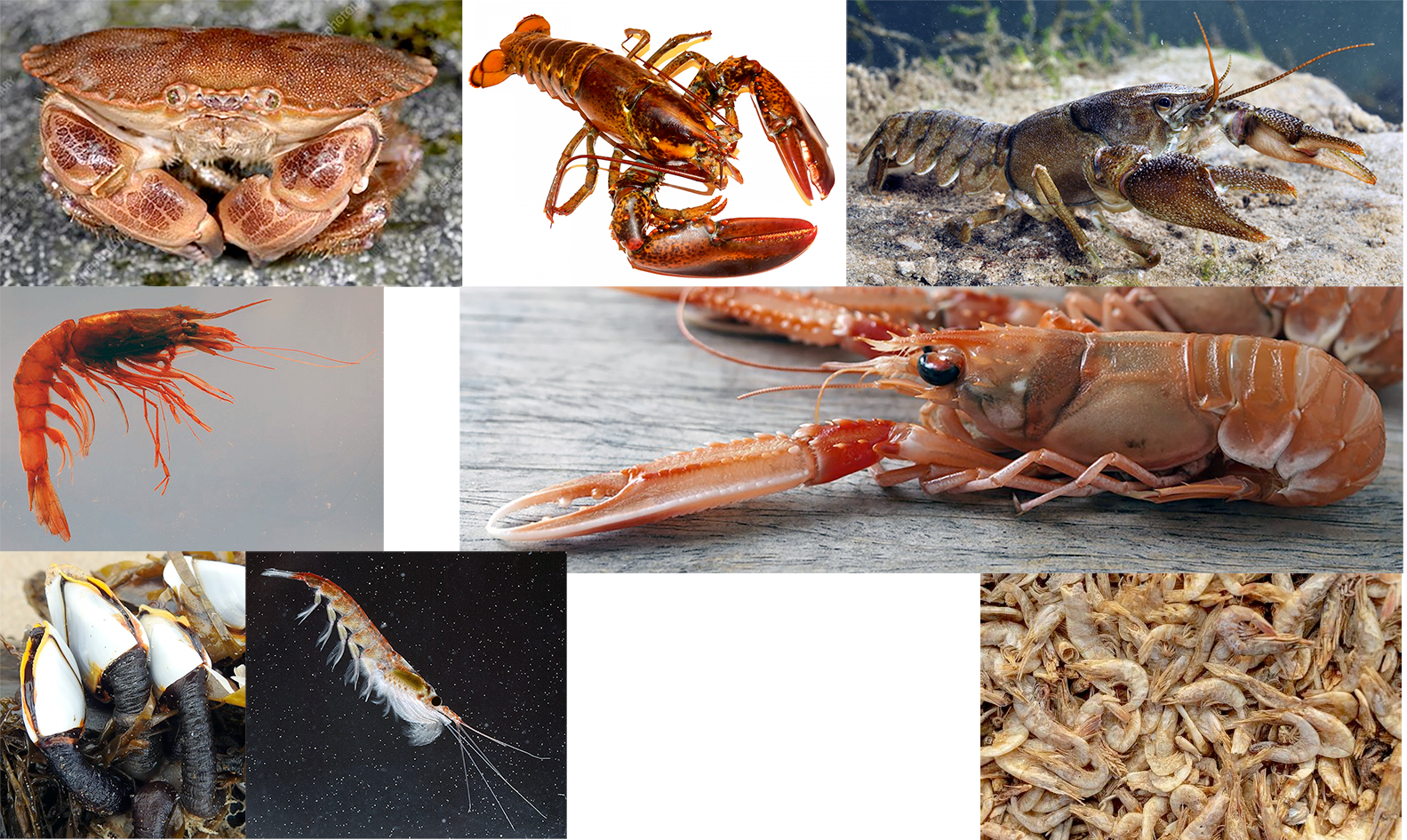FabulousFusionFood's Crustacean-based Recipes 4th Page
 top: Grilled lobster, crab curry. Bottom: garlic prawns, boiled gooseneck barnacles.
top: Grilled lobster, crab curry. Bottom: garlic prawns, boiled gooseneck barnacles.
Welcome to FabulousFusionFood's Crustacean-based Recipes Page —Crustaceans (from Latin meaning: "those with shells" or "crusted ones") are invertebrate animals that constitute one group of arthropods that are traditionally a part of the subphylum Crustacea (/krəˈsteɪʃə/), a large, diverse group of mainly aquatic arthropods including decapods (shrimps, prawns, crabs, lobsters and crayfish), seed shrimp, branchiopods, fish lice, krill, remipedes, isopods, barnacles, copepods, opossum shrimps, amphipods and mantis shrimp. The crustacean group can be treated as a subphylum under the clade Mandibulata. It is now well accepted that the hexapods (insects and entognathans) emerged deep in the crustacean group, with the completed pan-group referred to as Pancrustacea. The three classes Cephalocarida, Branchiopoda and Remipedia are more closely related to the hexapods than they are to any of the other crustaceans (oligostracans and multicrustaceans).
Most crustaceans are free-living aquatic animals, but some are terrestrial (e.g. woodlice, sandhoppers), some are parasitic (e.g. Rhizocephala, fish lice, tongue worms) and some are sessile (e.g. barnacles). The group has an extensive fossil record, reaching back to the Cambrian. More than 7.9 million tons of crustaceans per year are harvested by fishery or farming for human consumption, consisting mostly of shrimp and prawns. Krill and copepods are not as widely fished, but may be the animals with the greatest biomass on the planet, and form a vital part of the food chain. The scientific study of crustaceans is known as carcinology (alternatively, malacostracology, crustaceology or crustalogy), and a scientist who works in carcinology is a carcinologist.
 top l to r: edible brown crab, lobster. crayfish/crawfish; centre l to r: prawn/shrimp. langoustine;
top l to r: edible brown crab, lobster. crayfish/crawfish; centre l to r: prawn/shrimp. langoustine;bottom l to r: gooseneck barnacle, krill and West African dried prawns.
The name "crustacean" dates from the earliest works to describe the animals, including those of Pierre Belon and Guillaume Rondelet, but the name was not used by some later authors, including Carl Linnaeus, who included crustaceans among the "Aptera" in his Systema Naturae. The earliest nomenclatural valid work to use the name "Crustacea" was Morten Thrane Brünnich's Zoologiæ Fundamenta in 1772, although he also included chelicerates in the group.
The traditional classification of Crustacea based on morphology recognised four to six classes. Bowman and Abele (1982) recognised 652 extant families and 38 orders, organised into six classes: Branchiopoda, Remipedia, Cephalocarida, Maxillopoda, Ostracoda, and Malacostraca. Martin and Davis (2001) updated this classification, retaining the six classes but including 849 extant families in 42 orders. Despite outlining the evidence that Maxillopoda was non-monophyletic, they retained it as one of the six classes, although did suggest that Maxillipoda could be replaced by elevating its subclasses to classes. Since then phylogenetic studies have confirmed the polyphyly of Maxillopoda and the paraphyletic nature of Crustacea with respect to Hexapoda. Recent classifications recognise ten to twelve classes in Crustacea or Pancrustacea, with several former maxillopod subclasses now recognised as classes (e.g. Thecostraca, Tantulocarida, Mystacocarida, Copepoda, Branchiura and Pentastomida).
Many crustaceans are consumed by humans, and nearly 10,700,000 tons were harvested in 2007; the vast majority of this output is of decapod crustaceans: crabs, lobsters, shrimp, crayfish, langoustine and prawns. Over 60% by weight of all crustaceans caught for consumption are shrimp and prawns, and nearly 80% is produced in Asia, with China alone producing nearly half the world's total. Non-decapod crustaceans are not widely consumed, with only 118,000 tons of krill being caught, despite krill having one of the greatest biomasses on the planet. Krill are, however, a speciality in China and Japan and are used pickled in Korea. They are also consumed in Artic regions and are being introduced to new consumers as fusion recipes using frozen and tinned krill. Gooseneck barnacles (Pollicipes pollicipes) are a speciality of Spanish cuisine (recipes including krill and gooseneck barnacles can be found in the links below). The Pacific goose barnacle, Pollicipes elegans is also consumed, particularly in Alaska. The Japanese goose barnacle, Capitulum mitella is eaten in Japan. The Chilean giant barnacle or picoroco (Austromegabalanus psittacus) is routinely fished for food. Woodlice are sometimes consumed by foragers. Dried prawns (locally known as crawfish) are used as a flavouring and thickener in West African stews.
The alphabetical list of all the Crustacean-based recipes on this site follows, (limited to 100 recipes per page). There are 550 recipes in total:
Page 4 of 6
| Le cassoulet de la mer à la bretonne (Breton seaside cassoulet) Origin: France | Megrim Sole Olives with Squat Lobster Stuffing Origin: Britain | Ojojo Origin: Nigeria |
| Le Chao Men (New Caledonian Chaw Mein) Origin: New Caledonia | Microwave Jambalaya (x) Origin: Britain | Ouassous dans la nage (Ouassous in the swim) Origin: Guadeloupe |
| Le Ndolé Camerounais (Cameroonian Ndolé) Origin: Cameroon | Microwave Prawn Gumbo Origin: Britain | Pâtissons Farcis (Stuffed Squash) Origin: Mauritius |
| Lemon Chilli Chicken Origin: Cocos Islands | Microwave Three Fish Soup Origin: Britain | Pè Thee Thoke (String Bean Salad) Origin: Myanmar |
| Lemongrass Curry Origin: Cambodia | Mini Crab Cakes Origin: Fusion | Pad Thai Origin: Thailand |
| Lime-cured New Caledonian Blue Prawn Salad Origin: New Caledonia | Miti Hue (Fermented Coconut Sauce) Origin: Tahiti | Paella de Carne de Caza (Bushmeat Paella) Origin: Equatorial Guinea |
| Lobster and Clotted Cream Tart Origin: Britain | Monkfish Skewers with Coconut and Coriander Origin: Britain | Paella Valencia Origin: Spain |
| Lobster Croquets Origin: British | Monlar Oo Chin Ye Hin (Myanmar Tangy Soup) Origin: Myanmar | Palaver 'Sauce' Origin: West Africa |
| Lobster Curry Origin: Britain | Montserrat Jerk Prawns Origin: Montserrat | Palm Butter Soup Origin: Liberia |
| Lobster Sauce for Fish Origin: Britain | Moqueca de Camarão (Prawn Stew) Origin: Angola | Pan-fried Squat Lobsters Origin: England |
| Locusta Elixa cum Cuminato (Boiled Lobster with Cumin Sauce) Origin: Roman | Mozambique Prawns Origin: Mozambique | Panang Curry Paste Origin: Thailand |
| Locustam et Scillas (Lobsters and Prawns) Origin: Roman | N'dolé (Bitterleaf Stew) Origin: Cameroon | Partan Bree Origin: Scotland |
| Locustas Assas sic Facies (Roast Lobster is Made Thus) Origin: Roman | N'dolé avec Poulet (Chicken N'Dolé) Origin: Cameroon | Pawpaw Stew Origin: Ghana |
| Logosta Assada (Roasted Lobster) Origin: Guinea-Bissau | Nam Prig Pow (Roasted Chilli Paste) Origin: Thailand | Pazun Hin (Prawn Curry) Origin: Myanmar |
| Lourenço Marques Prawns Origin: South Africa | Nam Prig Pud (Fried Chill Paste) Origin: Thailand | Pe Kyar Zan Thoke (Glass Noodle Salad) Origin: Myanmar |
| Maelgi Rhost a Saws Bara Lawr (Roast Monkfish and Laverbread Sauce) Origin: Welsh | Nasi Goreng Istimewa (Fried Rice Breakfast) Origin: Indonesia | Peanut Soup Origin: West Africa |
| Maffi Hakko Bangtura (Sweet Potato Leaf Sauce) Origin: Guinea | Nasi Lemak Origin: Malaysia | Penang Prawn Curry Origin: Thailand |
| Malaysian Goat Rendang Origin: Malaysia | Nasi Lemak Origin: Cocos Islands | Pepes Ikan (Fish in Curry Sauce) Origin: Indonesia |
| Malaysian Kapitan Chicken Origin: Malaysia | Nasi Lemak Origin: Singapore | Pepes Ikan (Fish in Curry Sauce) Origin: East Timor |
| Malaysian Laksa Origin: Malaysia | Nasi Lemak Origin: Christmas Island | Percebes Tapas (Gooseneck Barnacles Tapas) Origin: Spain |
| Malaysian Lamb Rendang Origin: Malaysia | Ndolé à la Viande (Bitterleaf with Meat) Origin: Cameroon | Peri Peri Kari Camarão (Fiery Prawn Curry) Origin: Mozambique |
| Mallow Leaf Gumbo Origin: Britain | Ndomba de Poisson (Fish Cooked in Banana Leaves) Origin: Cameroon | Peri-peri Prawn Pasta Origin: South Africa |
| Mandarin Prawns Origin: Fusion | Nettle Greens and Peanut Stew Origin: African Fusion | Pickled Crabapple Origin: Britain |
| Mangalorean Prawn Sukka Origin: India | Nigerian Fresh Fish Pepper Soup Origin: Nigeria | Picoroco Tempura Origin: Chile |
| Mangoé Rafalari (Spicy Mango Stew) Origin: Guinea | Nigerian Guineafowl Pepper Soup Origin: Nigeria | Plateau de Fruits de Mer (Seafood Platter) Origin: France |
| Manhattan Seafood Stew Origin: American | Nigerian Pancakes with Prawns Origin: Nigeria | Port of Spain Crabs and Dumplings Origin: Trinidad |
| Masak Lemak (Cabbage in Coconut Milk Gravy) Origin: Malaysia | Nigerian Spiced Grasscutter Pepper Soup Origin: Nigeria | Portuguese Percebes Origin: Portugal |
| Massaman Curry Paste Origin: Thailand | Njandu Curry (Kerala Crab Curry) Origin: India | Poten Bwmpen (Marrow Pie) Origin: Welsh |
| Matapa de Abóbora (Pumpkin Matapa) Origin: Mozambique | Njanga Rice Origin: Cameroon | Potted Morecambe Bay Shrimps Origin: England |
| Matsavo (Pumpkin Leaf and Peanut Flour Stew) Origin: Mozambique | Nyeleng (Beef and Peanut Gumbo) Origin: Senegal | Potted Prawns Origin: Britain |
| Mauritian Prawn Curry Origin: Mauritius | Nyona Penang Assam Laska Origin: Malaysia | Potted Prawns II Origin: British |
| Mbanga Soup (Palm Nut Soup) Origin: Cameroon | Nyonya Curry Paste Origin: Singapore | Potted Squat Lobsters with Ginger and Basil Origin: Britain |
| Mbolo Origin: Equatorial Guinea | Ocopa de Camarones (Prawn Ocopa) Origin: Peru | |
| Mchuzi wa Kamba (Zanzibar Prawn Curry) Origin: Tanzania | Ofada-Ugba Jollof (Fermented Jollof Rice) Origin: Nigeria |
Page 4 of 6